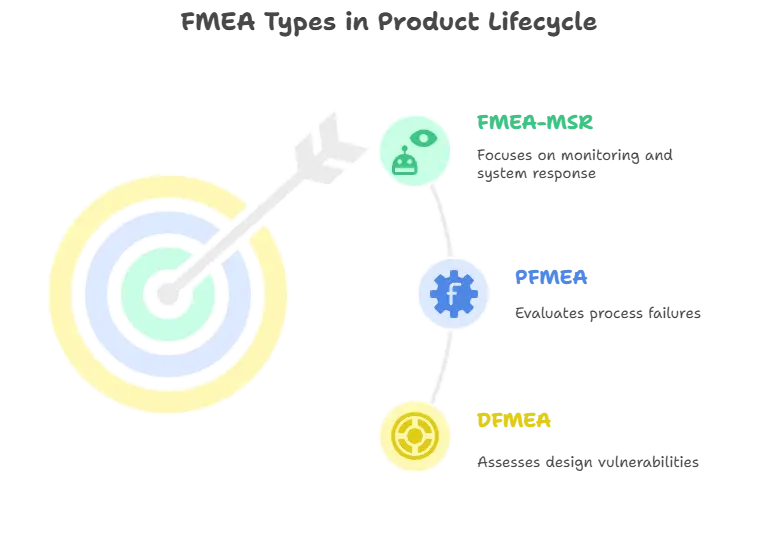In automotive product development and manufacturing, to know what could go wrong, before it happens is very important to maintain quality and safety. Therefore FMEA (Failure Mode and Effects Analysis), especially types of FMEA helps to deal with these at every stage.
But did you know there are three types of FMEA, each type is designed for a specific phase in the product lifecycle?
- DFMEA (Design FMEA)
- PFMEA (Process FMEA)
- FMEA-MSR (Monitoring and System Response FMEA)
Each FMEA type has a unique purpose, from preventing design failures to make sure robust production processes and monitoring those failures in operation.

Let’s dive into what each type means and how they are applied.
1️⃣ DFMEA – Design Failure Mode and Effects Analysis #
Purpose:
DFMEA is used to identify and prevent potential design-related failures before a part or system design is released for production.
Scope:
- Product functions
- Components and subsystems
- Design interfaces and interactions
- Engineering specifications
Use Cases Example:
- Electric motor design
- Brake caliper assembly
- Airbag deployment module
- ECU hardware/software
- Many more…
Example:
| Function | Potential Failure Mode | Effect | Cause |
| Alternator generates current | Output below voltage spec | Battery not charged | Undersized stator winding |
Action: Design specification, run thermal simulation, add margin in current-carrying capacity
DFMEA Output:
- DFMEA to Design Validation Plan (DVP&R)
- DFMEA to DFMEA report in PPAP
2️⃣ PFMEA – Process Failure Mode and Effects Analysis #
Purpose:
PFMEA is used to identify and mitigate failure risks in manufacturing or assembly processes.
Scope:
- Manufacturing and inspection steps
- Human, machine, method, material interactions
- Processes like Assembly, testing, welding, machining, etc.
Use Cases Example:
- Spot welding process
- Torque application on fasteners
- Injection molding
- PCB assembly
Example:
| Process Step | Failure Mode | Effect | Cause |
| Fastener torquing | Under-torqued joint | Vibration noise | Operator skipped step / tool error |
Action: Operator training, Work instruction, Install torque tool with poka-yoke interlock and add automatic data logging
PFMEA Output:
- PFMEA to Process Control Plan
- PFMEA to Operator Work Instructions
- PFMEA to Process Audit checklist
3️⃣ FMEA-MSR – Failure Mode and Effects Analysis for Monitoring and System Response #
Purpose:
FMEA-MSR evaluates how the system will respond to failures that occur during customer usage, especially when safety is involved.
This is critical in safety-critical systems where faults/failures cannot be entirely eliminated and monitoring becomes essential.
Scope:
- Vehicle operating phase (after SOP)
- Failure detection and monitoring strategies
- System behavior and driver warning response
Domains/Use cases:
- ADAS (Advanced Driver Assistance Systems)
- Electric Power Steering
- Battery Management Systems
- Brake-by-wire / Steer-by-wire
Example:
| Function | Failure Mode | Monitoring Strategy | System Response |
| Lane Keeping Assist | Camera failure | Diagnostic trouble code (DTC) triggered | System disabled + warning to driver |
Action: Add redundancy in sensors; define driver warning strategy in system logic
FMEA-MSR Output:
- FMEA-MSR → Functional Safety Case
- FMEA-MSR → ISO 26262 compliance documentation
Quick Comparison Table #
| Aspect | DFMEA | PFMEA | FMEA-MSR |
|---|---|---|---|
| Focus | Product Design | Manufacturing Process | In-use Monitoring |
| Applied During | Design Phase | Process Planning | Vehicle Operation |
| Prevents | Design Flaws | Process Failures | Uncontrolled In-Use Failures |
| Standards Linked | DVP&R, ISO 9001 | Control Plan, IATF 16949 | ISO 26262, Safety Case |
| Tools/Software | APIS IQ, Plato SCIO, TDC | APIS IQ, TDC | Safety FMEA Modules |
Summary #
| FMEA Type | Key Goal |
|---|---|
| DFMEA | Prevent design-level failures before launch |
| PFMEA | Eliminate process-level risks during production |
| FMEA-MSR | Ensure safe response to failures during customer usage |
To ensure world-class quality and functional safety, automotive OEMs and suppliers must apply all three types of FMEA at the right development stages.
Yes, for safety-critical systems. It’s a key part of ISO 26262 compliance.
Yes. Document each FMEA separately with its distinct scope, though you can link them for traceability.
DFMEA is performed first during design. PFMEA comes later during process planning. FMEA-MSR runs in parallel with DFMEA for safety-critical applications.



